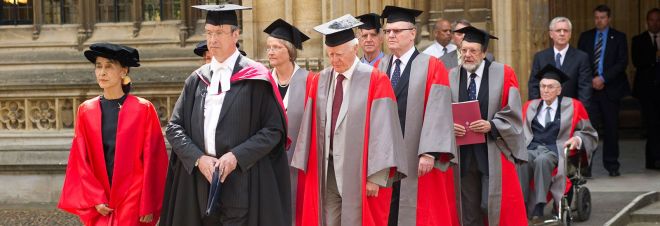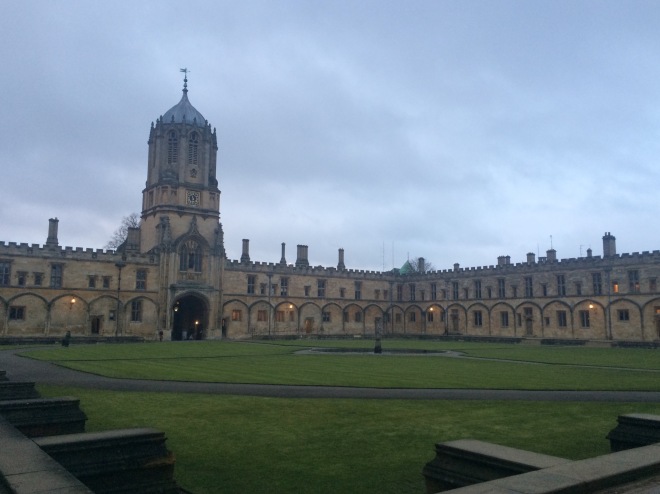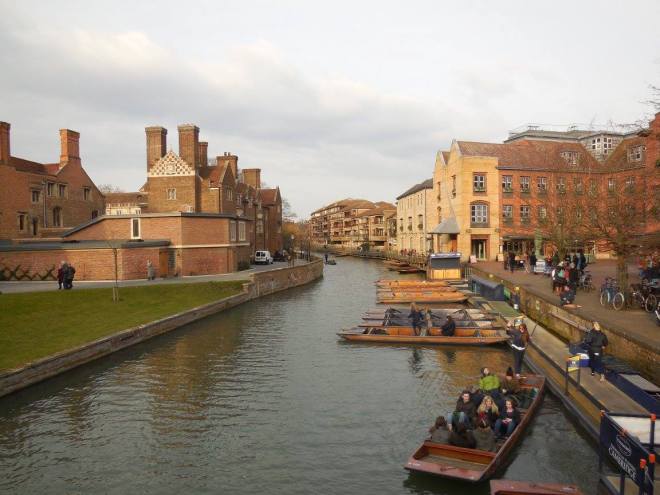(Editor’s Note: This post is made up of fragments of a field report I did for a writing class)

From talks and travels over the past two months, I’ve pieced together some perspective about what university student life is like around London and how diverse demographics emerge within it.
Throughout the term, I managed to venture to both Oxford and Cambridge to feel the original incarnations of the English college experience. The following report encapsulates my findings.
The University of Oxford – “The oldest university in the English-speaking world”
On a chilly, overcast Thursday in mid-March when my roommates all had class, I woke up early to trek out of the city and into Oxford. I made sure my phone was fully charged (without the Maps app, I nearly can’t function) and took off to Marble Arch station to find the Oxford Tube, a one-way shot from central London to Oxfordshire.
After wandering around the strange horse head statue outside of the Marble Arch tube station for a few minutes, I luckily caught sight of a kid with a blue tracksuit that had “OXFORD ROWING” screen-printed on its back in bold block lettering. I followed him across the plaza where the Arch sits and, sure enough, I found my bright red double-decker chariot.
I found my way to the second floor of the bus and gazed over at Hyde Park’s marble Italian Gardens as we began to head east along Bayswater Road. Upon shifting northeast at Shepherd’s Bush, the aftereffects of only sleeping five hours the night prior finally kicked in. I imagine the rest of the hour-long bus ride was filled with luscious landscapes and spectacular sights, but can’t be certain since I ended up dozing off until “Saint Aldate’s” was announced over the loudspeakers.
Finally awake and arrived in Oxford, I bustled off the bus and into an urban amalgamation of Romanesque, baroque, and English gothic architecture. I immediately check Maps, and walked a few yards to The University Church of St. Mary the Virgin, the first stop on my tour.
From what I read on various plaques inside, this church is the University of Oxford’s first building and from which the school grew. Judging from its gothic style, I imagined the church was old, but until I learned it was constructed in the 12th century, it didn’t hit me how old this institution truly is. The university has no known exact date of foundation, however, there has been evidence found of teaching as far back as 1096- almost a thousand years ago! Meaning, when the Mississippian Native American civilization was beginning to thrive across the pond via maize-based agriculture and shell tempered pottery, the English were founding an institution of higher education. Countless times the sheer oldness of Europe has left me flabbergasted this term.
What also interested me as I perused this ancient parish was to what effect religion played in student life at Oxford over the centuries. It surprised me to find out that, unlike Harvard or Yale who were founded by Puritans, Oxford was established by various religious orders. The school even allowed members of various religious orders, including Dominicans, Franciscans, Carmelites, and Augustinians to settle in Oxford in the mid-13th century and maintain halls for students. Most astonishing to me, however, was a fact that a pamphlet in the church noted: 12 saints studied at this prestigious university.
Following The University Church, I walked around the outside of Radcliffe Camera, an immaculate circular library not actually named after the photo-taking device or the Harry Potter actor, but a doctor named John Radcliffe and the Latin word for “room”. I then began exploring where students lived and studied, the colleges.
Coming in without much prior knowledge, I was also very confused about how this system was set up. Why are there 38 different “colleges” here? Are they all a part of Oxford? What’s the difference between them? Turns out, these colleges and permanent private halls are of religious foundation (many set up by the aforementioned religious orders) and are “autonomous self-governing corporations within the university”. Some required a fee to visit, so I made to have a university employee fully explain them to me before I threw down any money. These colleges are not only houses of residence, but have primary responsibility for student teaching and feature significant endowments. They tend to boast interesting names like Brasenose College, Christ Church, or Jesus College, and each generally specialize in certain subjects. Annoyingly, each college must be applied to individually when seeking Oxford admission.
Opting to not pay £10 to gain entry, I found my way into All Souls College by saying I was looking to attend graduate school there (perhaps not a lie, who knows). It featured a perfectly-cut lawn in its quad’s center as well as cozy living quarters inside the surrounding gothic buildings. I couldn’t help but think a computer would look out of place among the olden sensibilities of the place.
All Souls, which does not allow any undergraduate members, features a unique “Prize Fellowship” opportunity for graduate students. The competition, offered since 1878, features a series of written exams each September that include questions related to one’s line of study as well as two general questions. I read online that one previous general question has been: “Does the moral character of an orgy change when the participants wear Nazi uniforms?” Truly a head-scratcher.

After adequately being exposed to the fantasy-esque living and learning spaces of Oxford students, I was thoroughly parched. I took a recommendation from my cousin, Nick, who studied abroad at Oxford years ago, and found the infamous Turf Tavern. This extremely low-ceilinged pub is the oldest in Oxford, founded around 1381, and has been very popular for student socializing as well as betting throughout the centuries (This second fact reminded me of the original stock market coffee shops from Georgian London). However, hilariously, what this tavern most blatantly advertises is its connection with our 42nd president, Bill Clinton. As the story goes, Clinton studied at Oxford during his Rhodes scholar term in the Sixties and experimented with marijuana at the Turf Tavern. “I didn’t inhale and I didn’t try it again,” were Clinton’s notorious words that forever enshrined this dingy beer-serving cellar.
Yet despite the cramped quarters, sitting at the Tavern among students, eating a warm beef pie, and sipping a cider was the perfect end to my Oxford experience. Not to be seen were cards or games like I’ve seen at other pubs, but books filled the wall shelving. Also, out were debates about sports or celebrities, as I was surrounded by young scholars quipping about politics, books, and research undertaken. It perfectly wrapped up what I’d been feeling about Oxford: age-old tradition, detachment from urban hubbub, and strict studies with a touch of pretention sprinkled in for good measure.
The University of Cambridge – The second half of “Oxbridge”
Following my trip to Oxford, I was unsure about the necessity of heading north to Cambridge. Travel blogs online couldn’t offer a definitive answer and I felt it might be one of those “If you’ve seen one, you’ve seen them all” situations. Luckily, my roommates were extremely adamant about seeing the second-oldest university of the English speaking world and we took the National Rail service from King’s Cross to Cambridge last Saturday.
Immediately upon entering the town of Cambridge, we were confronted with more ancient architecture, however, perhaps partly due to the shining sun, this town appeared much more beautiful than Cambridge. As we first mingled around an outdoor market where Jack bought an Indiana Jones hat and I copped fried dumplings, I felt this was noticeably different than the urban environment Oxford offered. I remember reading online prior that Oxford was initially a town where the university was eventually built in; however, Cambridge was a university first around which a town formed. From the organized streets, expansive lawns, and overall space of the university, I felt Cambridge had its own distinct makeup. It’s more of the yin to Oxford’s yang, rather than a blatant copy.
How Cambridge came to be, though, is partially lost in history and perhaps shrouded by sin. A student research project linked to Cambridge’s website titled “Cambridge University – the Unauthorized History” states that just over 800 years ago, the university was founded by Oxford scholars “fleeing persecution during a period of conflict between church and state”. In 1209, power struggles were going on all over Europe, notably whether King John or Pope Innocent III should appoint the next Archbishop of Canterbury. Reports say that successive popes in the twelfth and thirteenth centuries incited the mob against lepers, gays, Jews, and others, in the process of forming a culture of persecution of outsiders. As Oxford townsfolk began carrying out this discrimination in violent ways, the scholars dispersed to Cambridge.
As my roommates and I walked around the campus, it’s clear that certain traditions weren’t lost upon creating this second English university. Cambridge sports 31 colleges within the greater university, such as Trinity College, Queen’s College, and another Jesus College. Certain ones have specific specialties and others only accept women or postgraduates, but what most distinguishes each school are their distinct scarf colors- something J.K. Rowling must’ve been inspired by when creating the Hogwarts “Houses”.
Jack, our other roommate Ish, and I choose, once more, not to pay for the overpriced tickets to visit the colleges, so we wandered down to the River Cam that runs through campus in search of entrance. But before we made our way into any colleges, we took a moment to figure out what in the world was going on with the men standing on wooden boats with long poles in hand. We realized that since the river is shallow and gravelly, “punters” are able to propel themselves along the Cam and travel along the campus’ immaculate tan gothic university buildings and botanical gardens. While this activity exists in Oxford, its far more popular in Cambridge.

My crew and I eventually decided it was a bit too cold for punting still and wandered until we snuck past security and into Darwin College. As you might assume, this school was named after the English naturalist Charles and sits just yards away from the river. It’s the home of solely graduate students and even features its own boat club. We had the incredible opportunity to walk around the student-only grounds of the college and were absolutely awestruck by the stunningly quaint sights that reminded us of The Shire.
The rest of the day was spent dipping into as many colleges as we could and ceaselessly ogling at the awesomeness of Cambridge. Over the best Moroccan food I’ve ever had, we talked at dinner about the distinct nuances that this illustrious school exhibits. I noted how much more beautiful the campus was designed over Oxford due to the space available centuries ago as well as how science seemed to be a greater focus here. Jack explained that he couldn’t help but feel overwhelmed by the grandiose buildings and over-the-top scholarly atmosphere. “A school needs a bit of utilitarianism like Posvar at Pitt, I couldn’t get any work done if everything looked like the Cathedral of Learning,” he chirped. Ish meanwhile said he’d undoubtedly study here without question, regardless of any extreme opulence or pretentiousness.
FINAL THOUGHTS
-While Oxford is known to be more ‘arty’ and liberal artsy, Cambridge is more science-focused.
-At either of these universities, there weren’t any of the “F##K PENN STATE” type of vibes that you feel around Pitt’s campus. The Brit’s are definitely more mannerly.
-Stephen Hawking attended both unis over the course of his studies.
-Oxfordians, the snobby people who believe that Shakespeare couldn’t possibly have written his masterpieces due to his lack of prestigious education, are super annoying.

Thank you so very much for sharing your insightful and Delightful observations of your time on ENGLAND! I was exactly your age when I first arrived in London. Your observations of class, fashion , music , food etc. are unique and also are not too different from my own. I was there in Mary Quant, the Beatles and Rolling Stone days. Mini skirts and biker boots. Procol Harem and the Whiter Shades of Pale. I desperately fell in love with England. Your blog has been such a joy . You have delved deep. You absolutely GOT it. Thank you!
LikeLike
Mary, thank YOU for the comment and kind words! It’s been an unbelievable time abroad and only a morsel of the fun was able to be blogged. Can’t wait to talk more about it when the families next meet up! (Also, I strangely hadn’t heard of Procol Harum before, but wow what an awesome track)
LikeLike